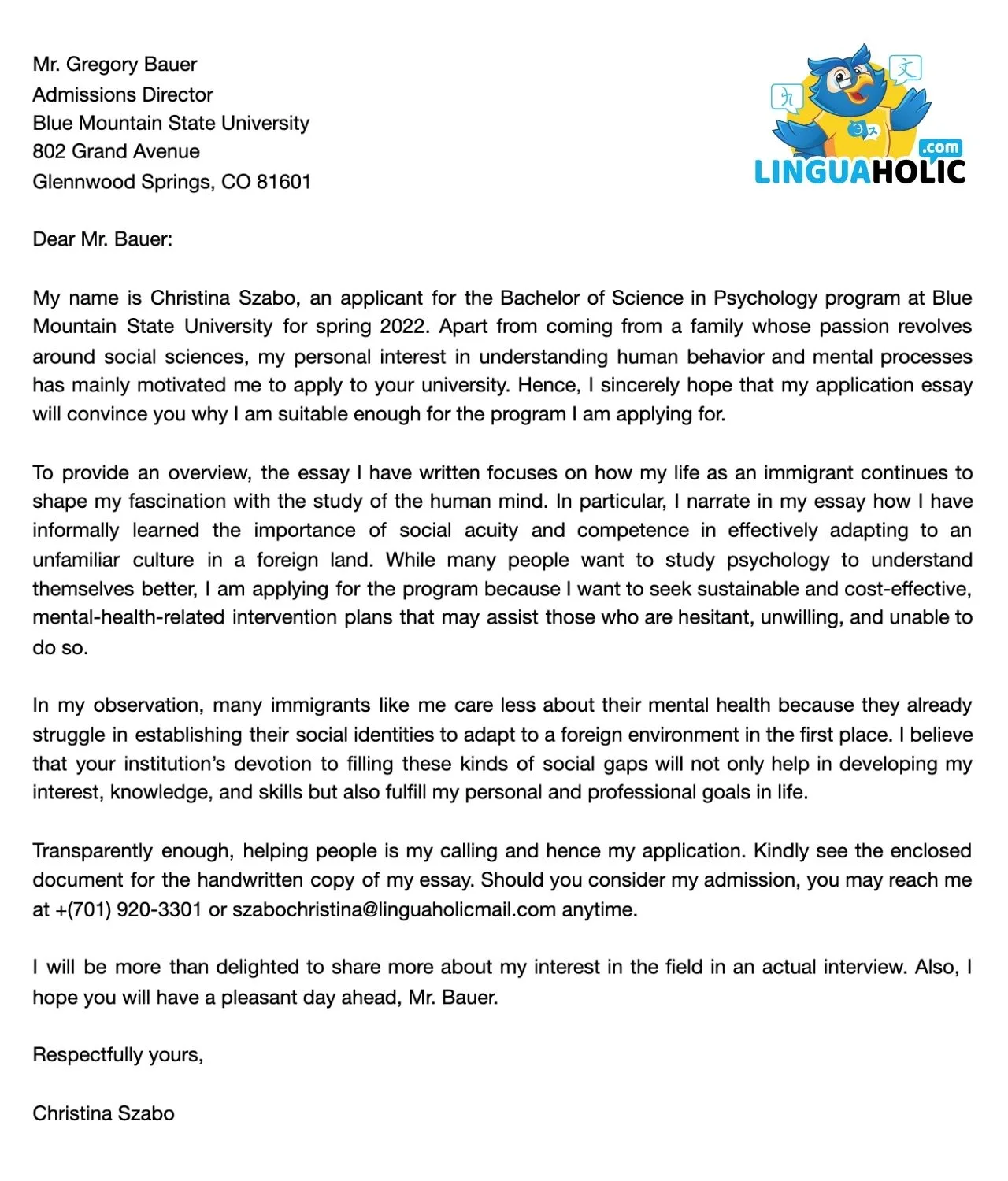No matter what field you want to explore, decision-makers would always consider communication skills as a default requirement in all contexts.
One of the hardest-to-master communication skills is writing because of the absence of the writer’s voice, facial expressions, and body gestures in the final output.
And, one of the most challenging things to write about is anything related to formal correspondence such as cover letters.
To address this concern, today’s post aims to discuss writing a cover letter in detail, particularly the one intended for introducing an essay.
How can we write a cover letter for an essay?
- Write the inside address
- Use a formal salutation
- Establish credentials and state the purpose
- Express enthusiasm
- Set expectations
- Provide the essay’s overview
- Explain the essay’s implications
- Restate interest
- Mention enclosures
- Prompt a response
- Provide contact details
- End positively
- Close and sign
The anatomy of a cover letter for an essay
A cover letter for an essay is a written document that may be a part of an educational institution’s major requirements for admitting a student or faculty applicant.
It is created to briefly introduce and describe the content of an essay written by an applicant, as well as for evaluating written communication skills.
Apart from the essay overview, this kind of cover letter also contains other essential elements like the writer’s credentials, elaboration of candidature, as well as enclosure and contact information.
As an essay cover letter is sometimes mandated by schools so they can decide whether to admit or reject an application, this document needs to be written meticulously.
To understand what writing an essay cover letter entails, the next section elaborates on the general steps in creating this document.
Steps to writing a cover letter for an essay
Essays are an important indicator of how well a person can organize and communicate his or her ideas through written language.
In addition, essays are also a crucial assessment tool used by many, if not all, educational institutions in understanding their members’ values, aspirations, and attitudes.
While every writer has a unique set of knowledge and life experiences, every essay also has a particular theme, purpose, and target audience.
The combination of the elements listed above significantly affects how a writer arranges his or her ideas to be able to put them into words; this is otherwise known as effective writing strategies.
Apparently, the essay per se already needs much time and effort to get done; even more so, the cover letter requires customization to convince the addressee to read the essay.
In a nutshell, the importance of this document boils down to the fact that an applicant may not be able to achieve his or her academic or career goals without hypercritically tailoring the cover letter.
Here are the general steps on writing an essay cover letter together with example scripts:
1. Write the accurate inside address
Every cover letter must start with the inside address — the information as to whom and to where the letter is addressed.
Make sure you research the correct details to ensure that your letter goes to the right person and location rather than tossed around.
Also, make sure to apply proper punctuation rules by using commas in the inside address correctly to demonstrate a non-mediocre written language competence.
Here’s an example for your reference:
Example:
Ms. Celine Trumann
Admissions Director
Fargo State College
9201 32nd Street
Fargo, ND 58104
2. Use a formal salutation or greeting
A formal salutation or greeting is one key element in cover letters because it signals the target recipient that you are specifically addressing him or her.
For this part, you have to avoid greetings with relatively personal and casual connotations like “Dearest Sarah” and “My dearest Jerry.”
You must also steer clear of “the most uncertain salutation” in English which is “To Whom It May Concern” because doing so easily invites impressions of laxity or even negligence.
In particular, formal letters entail formal salutations like the following examples:
Example 1:
Example 2:
Example 3:
3. Establish credentials and state the purpose
Establishing the credentials simply means writing down your complete name and other relevant information that would help the address identify you easily.
Meanwhile, the statement of purpose refers to the intent of writing the cover letter, which is often the application for a particular role, especially in institutional bodies like universities.
You may simply condense these two elements such as the following example statement:
Example:
4. Express enthusiasm on the application
Then, you have to express your enthusiasm in whatever role you are applying for to explicitly communicate your interest in whatever role you are aspiring to have.
This statement should not be too personal or emotional to avoid impressions of being pretentious or condescending.
Maintaining a professional yet thoughtful tone throughout the letter is tantamount to a high chance of admission.
You may express your enthusiasm as follows:
Example:
5. Set the reader’s expectation
Your target reader highly likely needs to go over numerous documents daily, hence it would be helpful if you could set his or her expectations after reading your essay.
Setting the expectation simply means explaining what the reader would accomplish after reading your essay.
Moreover, you can also make this part strategic in the sense that you are advocating for yourself to get admitted, for instance, to the program you are applying for.
You may set the reader’s expectation like this:
Example:
6. Provide an overview of the essay
As you are writing a cover letter for an essay, which may also be sometimes referred to as a personal statement, you are obliged to explain what the essay is all about.
This part aims to provide an initial contextualization of your essay, which would effectively assist the target reader’s comprehension.
Here’s an example of how you can write an overview of your essay:
Example:
7. Explain the implications of the essay
Clearly enough, providing an overview of what your essay is all about may not be adequate enough.
Therefore, you should also be able to explain the underlying message of your written output to really let the reader see the bigger picture.
The implication of your essay, once again, boils down to you being admitted to the role you are applying for, as well as how the addressee would benefit from your possible admission.
The implication part may look like the following:
Example:
8. Reiterate interest on the admission
More or less until this point, you have mainly been focusing on introducing and describing your essay to the addressee.
So, it is essential to remind the addressee one more time of why you are a suitable candidate for the role you want to be admitted to.
You can simply reiterate your interest in the admission this way:
Example:
By this point, I hope I have somehow convinced you as to why I am a good fit for the program I am applying for.
9. Mention enclosures or attachments
Your cover letter is intended specifically for igniting the target reader’s interest in reading the complete version of your essay.
So, he or she also needs to be reminded that more detailed information about the essay is yet to come afterward.
This part will also ensure that your reader gets to read the entire content of your essay rather than toss it somewhere else.
The term “enclosure” by the way is specifically used for written or printed documents, whereas the word “attachment” is used in writing emails that are exchanged virtually.
You can remind your reader of your enclosed or attached essay by using a statement as simple as this:
Example:
10. Prompt a response
The next crucial part of your cover letter entails soliciting a positive response to your application by inviting you to an interview.
This means that you need to prompt or encourage the reader to contact you for an actual discussion so that you can share more of why you can be an asset to the target organization.
Here’s how you can execute this strategy politely yet enthusiastically:
Example:
11. Provide contact information
Ending an email or letter professionally entails the use of certain expressions that welcome the possibility of future correspondence, which also means that you must provide your contact information.
You may have already given your contact details when you were asked to fill up a personal datasheet, but you would also want to make the reader’s life as convenient as possible.
Hence, you should not forget to provide your active contact details in your cover letter so that the addressee can retrieve them with ease.
To provide your contact information, you can write something like this:
Example:
12. End with a positive note
If you wish to explicitly demonstrate your positive values, do not hesitate to write a short piece of pleasantry toward the end of your cover letter.
Again, it is needless to say that you have to maintain a formal yet non-pretentious tone in writing this part of your letter.
Please refer to the example below as to how you can implement such a strategy:
Example:
13. Close and sign the cover letter
A formal valediction or closing remark is also as vital as your formal salutation or greeting because this officially marks the end of your cover letter.
Therefore, you must never forget this part together with your complete name that serves as your signature.
Avoid using closing remarks with an overly personal connotation like “Warmest regards” or something that can be associated with casual emails like “Best” or “Cheers.”
Example 1:
Sincerely,
Caitlyn Kaufman
Example 2:
Respectfully,
Peter Everet
Full Sample cover letter for an essay
To see the overall picture, here is a sample cover letter for an essay that you may refer to as you wish:

Frequently Asked Questions on “How to Write a Cover Letter for an Essay”
What is a cover letter?
A cover letter is a document that introduces and describes one’s intent to obtain a certain role. It is often submitted with other documents like resumes and personal statements. A cover letter is also sometimes called a motivational letter.
What is a cover letter for an essay?
A cover letter for an essay or personal statement is a formal letter that briefly describes the content of an enclosed or attached essay. This document may be required by some institutions in admitting student and faculty applicants.
What is a cover letter in APA style?
A cover letter that necessitates guidelines recommended by the American Psychological Association (APA) is a document that is submitted with manuscripts when applying for a journal publication.
Conclusion
Writing a cover letter becomes a lot easier through repetitive execution and, of course, more personal and professional experiences.
Even if tailoring cover letters is a bit taxing, this skill is integral in achieving either or both our personal and professional goals in life; hence, a necessary evil.

Hey fellow Linguaholics! It’s me, Marcel. I am the proud owner of linguaholic.com. Languages have always been my passion and I have studied Linguistics, Computational Linguistics and Sinology at the University of Zurich. It is my utmost pleasure to share with all of you guys what I know about languages and linguistics in general.

